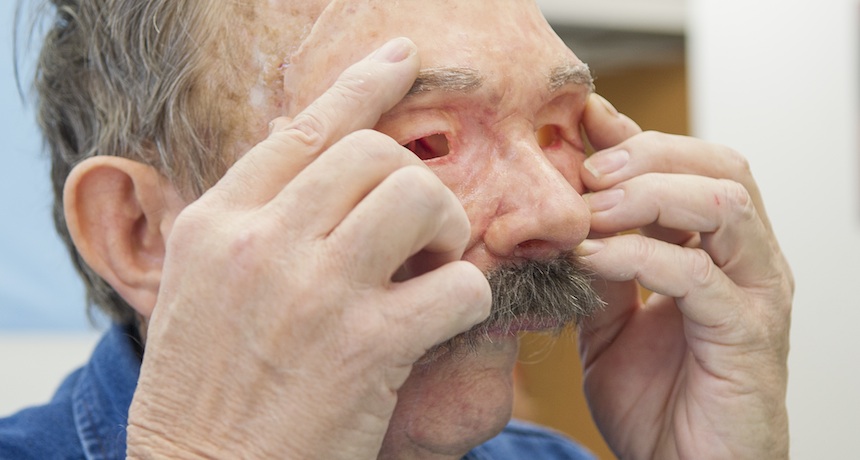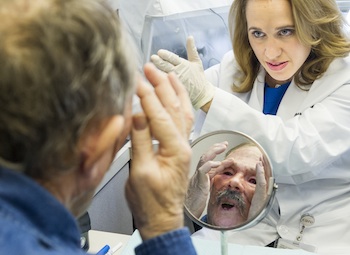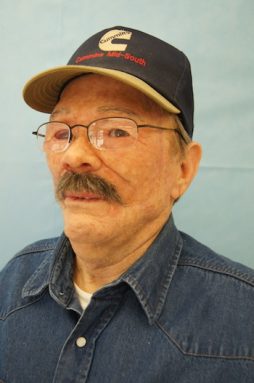When a part makes you whole
A high-tech artificial face restores confidence and self-esteem to patients

Billy Crawford, of Lockesburg, Ark., tries on a facial prosthetic created to match his skin tone and texture. Crawford lost much of the skin and underlying tissue on his upper face due to a skin infection.
Texas A&M Univ. Baylor Coll. of Dentistry
By Sid Perkins
SAN JOSE, Calif. — A creative combination of technologies is offering hope to people disfigured by an accident, disease or birth defect. The end result is an artificial body part that is startlingly lifelike. The anatomical add-on can do more than provide a patient with a more natural-looking appearance. It also can restore a person’s self-esteem and confidence.
Many injuries or diseases can dramatically affect a person’s appearance. Burns can scar flesh. Infections can eat away at skin and the tissues beneath. Auto accidents can create horrendous gashes. Tumors, once removed, may leave large holes.
People who suffer such disfigurements sometimes want to withdraw from the world, says Suzanne Verma. She’s an anaplastologist (ann-uh-plass-TOH-luh-gist). That is someone who designs and builds artificial body parts or prostheses (pross-THEE-sees). Verma works in Dallas at the Texas A&M University Baylor College of Dentistry. She specializes in prostheses to restore malformed or missing body parts. But she doesn’t work on legs or arms. Verma creates replacements for noses, ears — and sometimes entire faces.

Her team starts with a computer that develops a detailed model of the patient’s face. Medical CT scans can provide data for such a model. That technology uses X-ray scans from many angles to create three-dimensional views of a human body. In Crawford’s case, Verma modeled his face using scans doctors had made of his face before the infection. In other cases, such data may come from an intact body part on the other side of a patient’s body. Experts can even use data from other people, if necessary.
The team then uses a three-dimensional printer to make a replica of the missing tissue or body part. That could be something as simple as a smooth area of skin. Or it could be as complicated as an ear or nose, Verma notes. With Crawford, she restored a large portion of his face. This included his eyebrows, eyelids, nose and upper lip.
The experts use their model to create a mold. Finally, they make the prosthesis from that mold. The prosthesis typically is made of silicone.
When making the mold, an anaplastologist must carefully add surface details, such as wrinkles and pores. That way, the prosthesis can better match the natural texture of the patient’s face, Verma told Science News for Students. To make the device look even more natural, the anaplastologist can add other small details. For example, the first layers of material added to the mold can be colored to match a person’s skin tone. Thin, colored fibers can be implanted in the silicone to simulate small blood vessels. Other facial features such as wrinkles can be added. For Crawford, Verma also added a mustache and eyebrows made from his own hair.

All of these steps require great care, says Verma. They also can take a good deal of time. The prosthetic can be made in two weeks or less. But it may take several weeks for the bones and skin to heal around the mounting posts.
The end results can be astonishing, both to the patient and to others. “Once we’ve restored the anatomy, the person can feel whole once again,” says Verma. “They can heal emotionally as well as physically.”
Regaining that feeling is extremely important, says Luisa DiPietro of the University of Illinois at Chicago. She’s an immunologist. That is someone who studies the immune system and how bodies heal. “Often a person can come to terms with their deformity but still not want to go out,” she explains. “A prosthetic helps them live their life normally without attracting stares or unwanted attention.”
Prosthetics are often the best treatment option for many patients, DiPietro says. A patient might be a good candidate for a face transplant, for example. But for the rest of their life, they would have to take drugs that lower the chances that the transplant will be rejected. Those drugs also may increase the risk of dangerous infections. So, a prosthetic might be better in the long run.
In the end, making prosthetics is as much an art as a science, says Verma: “Technology is our palette, and creativity is our brush.”
Power Words
(for more about Power Words, click here)
anaplastologist A specialist who designs and builds prostheses to restore malformed or missing parts of the human body that don’t bear weight. (A different type of specialist designs and builds prostheses that undergo stress, such as artificial legs, knees and arms.)
computerized axial tomography (CAT or CT, for short). A special kind of x-ray scanning technology that produces cross-sectional views of the inside of a bone or body.
fungus (plural: fungi) One of a group of single- or multiple-celled organisms that reproduce via spores and feed on living or decaying organic matter. Examples include mold, yeasts and mushrooms.
immune system The collection of cells and their responses that help the body fight off infection.
immunology The field of biomedicine that deals with the immune system.
infection A disease that can spread from one organism to another.
magnet A material that usually contains iron and whose atoms are arranged so they attract certain metals
prosthesis (plural prostheses) An artificial device that replaces a missing body part. Such a prosthetic limb, for example, would replace parts of an arm or leg. These replacement parts usually substitute for tissues missing due to injury, disease or birth defects.
prosthetic Adjective that refers to a prosthesis.
silicone Heat-resistant substances that can be used in many different ways, including the rubber-like materials that provide a waterproof seal around windows and in aquariums. Some silicones serve as grease-like lubricants in cars and trucks. Most silicones, a type of molecule known as a polymer, are built around long chains of silicon and oxygen atoms.
technology The application of scientific knowledge for practical purposes, especially in industry — or the devices, processes and systems that result from those efforts.
three-dimensional (3-D) printer A machine that takes instructions from a computer program on where to lay down successive layers of some raw material to create a three-dimensional object.
three-dimensional (3-D) printing The creation of a three-dimensional object with a machine that follows instructions from a computer program. The computer tells the printer where to lay down successive layers of some raw material, which can be plastic, metals, food or even living cells. 3-D printing is also called additive manufacturing.
transplant (in medicine) The replacement of a tissue or an organ with that from another organism. It is also a term for the material that will be transplanted.
tumor A mass of cells characterized by atypical and often uncontrolled growth. Benign tumors will not spread; they just grow and cause problems if they press against or tighten around healthy tissue. Malignant tumors will ultimately shed cells that can seed the body with new tumors. Malignant tumors are also known as cancers.
ultrasound Sounds at frequencies above the range that can be detected by the human ear. (adj. ultrasonic)







